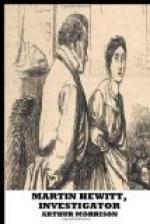“That is the case. It is an inner room, or, rather, a room parallel with the other, and communicating with it; just as your own room is, which we have just left.”
“But, then, you say you never left your office, and yet the drawings vanished—apparently by some unseen agency—while you were there in the room?”
“Let me explain more clearly.” The cab was bowling smoothly along the Strand, and the engineer took out a pocket-book and pencil. “I fear,” he proceeded, “that I am a little confused in my explanation—I am naturally rather agitated. As you will see presently, my offices consist of three rooms, two at one side of a corridor, and the other opposite—thus.” He made a rapid pencil sketch.
[Illustration]
“In the outer office my men usually work. In the inner office I work myself. These rooms communicate, as you see, by a door. Our ordinary way in and out of the place is by the door of the outer office leading into the corridor, and we first pass through the usual lifting flap in the barrier. The door leading from the inner office to the corridor is always kept locked on the inside, and I don’t suppose I unlock it once in three months. It has not been unlocked all the morning. The drawer in which the missing drawings were kept, and in which I saw them at ten o’clock this morning, is at the place marked D; it is a large chest of shallow drawers in which the plans lie flat.”
“I quite understand. Then there is the private room opposite. What of that?”
“That is a sort of private sitting-room that I rarely use, except for business interviews of a very private nature. When I said I never left my office, I did not mean that I never stirred out of the inner office. I was about in one room and another, both the outer and the inner offices, and once I went into the private room for five minutes, but nobody came either in or out of any of the rooms at that time, for the door of the private room was wide open, and I was standing at the book-case (I had gone to consult a book), just inside the door, with a full view of the doors opposite. Indeed, Worsfold was at the door of the outer office most of the short time. He came to ask me a question.”
“Well,” Hewitt replied, “it all comes to the simple first statement. You know that nobody left the place or arrived, except the postman, who couldn’t get near the drawings, and yet the drawings went. Is this your office?”
The cab had stopped before a large stone building. Mr. Dixon alighted and led the way to the first-floor. Hewitt took a casual glance round each of the three rooms. There was a sort of door in the frame of ground glass over the barrier to admit of speech with visitors. This door Hewitt pushed wide open, and left so.
He and the engineer went into the inner office. “Would you like to ask Worsfold and Ritter any questions?” Mr. Dixon inquired.
“Presently. Those are their coats, I take it, hanging just to the right of the outer office door, over the umbrella stand?”




